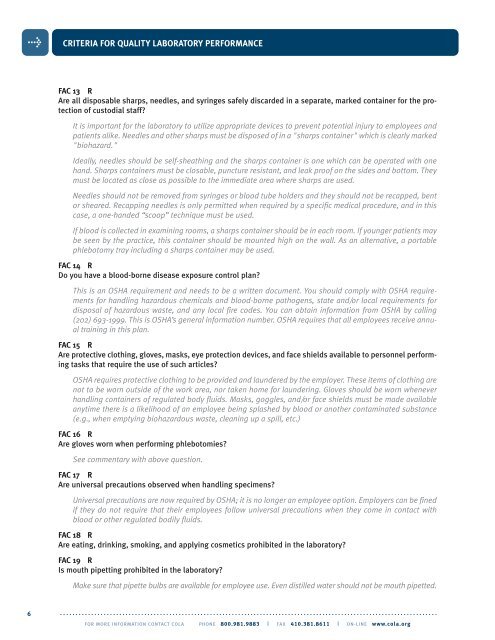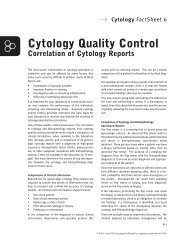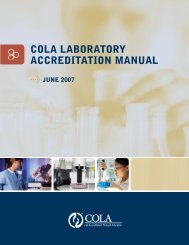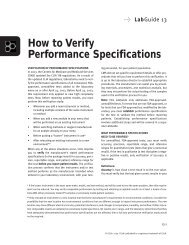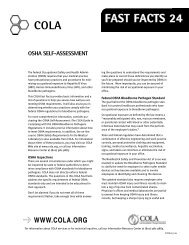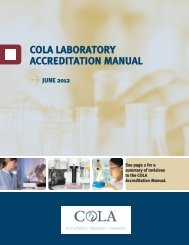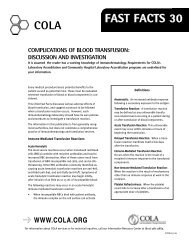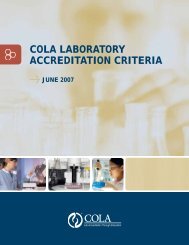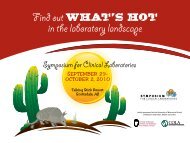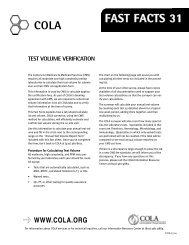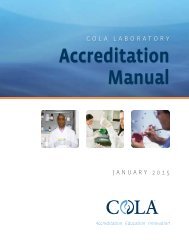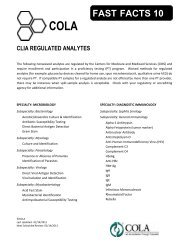#06-5558 Accrd Manual V7 - COLA
#06-5558 Accrd Manual V7 - COLA
#06-5558 Accrd Manual V7 - COLA
- No tags were found...
You also want an ePaper? Increase the reach of your titles
YUMPU automatically turns print PDFs into web optimized ePapers that Google loves.
CRITERIA FOR QUALITY LABORATORY PERFORMANCEFAC 13 RAre all disposable sharps, needles, and syringes safely discarded in a separate, marked container for the protectionof custodial staff?It is important for the laboratory to utilize appropriate devices to prevent potential injury to employees andpatients alike. Needles and other sharps must be disposed of in a "sharps container" which is clearly marked"biohazard."Ideally, needles should be self-sheathing and the sharps container is one which can be operated with onehand. Sharps containers must be closable, puncture resistant, and leak proof on the sides and bottom. Theymust be located as close as possible to the immediate area where sharps are used.Needles should not be removed from syringes or blood tube holders and they should not be recapped, bentor sheared. Recapping needles is only permitted when required by a specific medical procedure, and in thiscase, a one-handed “scoop” technique must be used.If blood is collected in examining rooms, a sharps container should be in each room. If younger patients maybe seen by the practice, this container should be mounted high on the wall. As an alternative, a portablephlebotomy tray including a sharps container may be used.FAC 14 RDo you have a blood-borne disease exposure control plan?This is an OSHA requirement and needs to be a written document. You should comply with OSHA requirementsfor handling hazardous chemicals and blood-borne pathogens, state and/or local requirements fordisposal of hazardous waste, and any local fire codes. You can obtain information from OSHA by calling(202) 693-1999. This is OSHA’s general information number. OSHA requires that all employees receive annualtraining in this plan.FAC 15 RAre protective clothing, gloves, masks, eye protection devices, and face shields available to personnel performingtasks that require the use of such articles?OSHA requires protective clothing to be provided and laundered by the employer. These items of clothing arenot to be worn outside of the work area, nor taken home for laundering. Gloves should be worn wheneverhandling containers of regulated body fluids. Masks, goggles, and/or face shields must be made availableanytime there is a likelihood of an employee being splashed by blood or another contaminated substance(e.g., when emptying biohazardous waste, cleaning up a spill, etc.)FAC 16 RAre gloves worn when performing phlebotomies?See commentary with above question.FAC 17 RAre universal precautions observed when handling specimens?Universal precautions are now required by OSHA; it is no longer an employee option. Employers can be finedif they do not require that their employees follow universal precautions when they come in contact withblood or other regulated bodily fluids.FAC 18 RAre eating, drinking, smoking, and applying cosmetics prohibited in the laboratory?FAC 19 RIs mouth pipetting prohibited in the laboratory?Make sure that pipette bulbs are available for employee use. Even distilled water should not be mouth pipetted.6. . . . . . . . . . . . . . . . . . . . . . . . . . . . . . . . . . . . . . . . . . . . . . . . . . . . . . . . . . . . . . . . . . . . . . . . . . . . . . . . . . . . . . . . . . . . . . . . . . . . . . . . . . . . . . . . . . . . . . . . .FOR MORE INFORMATION CONTACT <strong>COLA</strong> PHONE 800.981.9883 | FAX 410.381.8611 | ON-LINE www.cola.org


